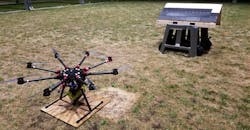Robotic Flying Drone Designed to Nail Down Roofing Shingles
Graduate engineering students at the University of Michigan have developed a flying drone, an octocopter, that can autonomously nail down shingles on a roof. This aerial vehicle is autonomous, so it can position the electric nailgun on a nailing point, trigger the gun to fire and pound the nail in, then move to the next nailing point without needing a human at the controls.
Students broke down the overall task of nailing down a shingle into several smaller tasks such as telling the octocopter where the nails should go and triggering the nailgun. The team deployed a network of markers and stationary cameras that let the drone locate itself in space and then used this network to navigate the drone to where the nails should go.
To fire the onboard and off-the-shelf nailgun, they first measured the force needed to compress the point of the nailgun, which must be done before the nailgun can be triggered. Then, they wrote software that let the drone apply that force as it came down on the target point.
The off-the-shelf version of this electric nailgun requires a trigger to be compressed as well, but the team turned that into a virtual switch. This is activated when the drone gets in position to place a nail.
For now, the drone is slow compared to human roofers. “Initially, we tried using faster approach speeds to minimize nailing time,” says Matthew Romano, a robotics Ph.D. student. “However, on those attempts, the nailgun tip often bounced off the roof, which meant it either wouldn’t trigger or it would trigger in the wrong place.”
In addition to speed, the team identified other improvements that would be needed for a practical system. First, it should be powered by tether rather than battery. Both batteries and nailguns are heavy, but the drone in its own can only run for about 10 minutes. A tether supplying electricity would enable it to run indefinitely. And adding an air line running alongside the power cable would let the drone use a more effective pneumatic nailgun.
The current approach is also characterized somewhat by overkill: The network of cameras and markers is more complicated than a roofing drone actually needs. Shingles are already marked with a shiny adhesive strip and there are color differences between exposed portion of the shingle and the portion beneath the next layer of shingles. It would be easy to have a camera on the drone that could determine the shingle’s orientation and position.
“For me, the biggest excitement of this work is in recognizing that autonomous, useful, physical interaction and construction tasks are possible with drones,” says Ella Atkins, a professor of aerospace engineering and robotics. She adds that tasks best suited for robots are said to be “dull, dirty, and dangerous,” presumably letting humans handle the cleaner, safer, and more interesting jobs.
Already, drones replace humans in some dangerous jobs such as inspecting bridges, wind turbines, and cell towers. The next step, according to Atkins, is going from surveillance alone to performing physical tasks.
Below, watch a video of the drone nailing down roofing shingles:

